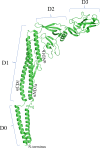Structural engineering of flagellin as vaccine adjuvant: quest for the minimal domain of flagellin for TLR5 activation
- PMID: 39775323
- PMCID: PMC11706886
- DOI: 10.1007/s11033-024-10146-y
Structural engineering of flagellin as vaccine adjuvant: quest for the minimal domain of flagellin for TLR5 activation
Abstract
Flagellin stimulates Toll-like receptor 5 (TLR5), triggering both innate and adaptive immune responses, making it a potential vaccine adjuvant. On mucosal surfaces, flagellin induces a strong release of cytokines, chemokines, and immunoglobulins. When used in its free monomeric form, flagellin has been shown to enhance immune responses when combined with vaccine antigens. Further research demonstrated that genetically linking flagellin to the antigen provides a more consistent immune boost. However, the bulky structure of flagellin presents challenges in designing the antigen-adjuvant construct, leading to ongoing research to determine the minimal flagellin domain necessary for its adjuvant effect. Early findings suggest that only the D0 and D1 domains are required for immune enhancement. Functional analysis revealed that the TLR5-binding region is located in the D1 domain, while TLR5 dimerization and signaling require the presence of D0. Further reductions in the size of the D0 and D1 domains may be possible as deeper studies aim to identify the key residues responsible for TLR5 activation and immune enhancement. Additionally, flagellin is being tested as a hapten carrier alongside its established adjuvant role. Recently, significant advancements in flagellin application have been observed as it progresses through clinical studies as an adjuvant, anti-radiation, and anti-cancer agent.
Keywords: Adjuvant; Dimerization; Flagellin; Hapten; TLR5.
© 2024. The Author(s).
Conflict of interest statement
Declarations. Competing interests: The authors declare no competing interests.
Figures




Similar articles
-
The role of the C-terminal D0 domain of flagellin in activation of Toll like receptor 5.PLoS Pathog. 2017 Aug 21;13(8):e1006574. doi: 10.1371/journal.ppat.1006574. eCollection 2017 Aug. PLoS Pathog. 2017. PMID: 28827825 Free PMC article.
-
Airway structural cells regulate TLR5-mediated mucosal adjuvant activity.Mucosal Immunol. 2014 May;7(3):489-500. doi: 10.1038/mi.2013.66. Epub 2013 Sep 25. Mucosal Immunol. 2014. PMID: 24064672
-
Recombinant flagellins with deletions in domains D1, D2, and D3: Characterization as novel immunoadjuvants.Vaccine. 2019 Jan 21;37(4):652-663. doi: 10.1016/j.vaccine.2018.12.009. Epub 2018 Dec 21. Vaccine. 2019. PMID: 30583910
-
AsialoGM1 and TLR5 cooperate in flagellin-induced nucleotide signaling to activate Erk1/2.Am J Respir Cell Mol Biol. 2006 Jun;34(6):653-60. doi: 10.1165/rcmb.2005-0441OC. Epub 2006 Jan 26. Am J Respir Cell Mol Biol. 2006. PMID: 16439799 Free PMC article. Review.
-
Deimmunization of flagellin adjuvant for clinical application.Curr Opin Virol. 2023 Jun;60:101330. doi: 10.1016/j.coviro.2023.101330. Epub 2023 Apr 19. Curr Opin Virol. 2023. PMID: 37084463 Review.
Cited by
-
Harnessing flagellin of Ligilactobacillus agilis as a surface display scaffold for an HIV-1 epitope.Appl Environ Microbiol. 2025 Jun 18;91(6):e0067425. doi: 10.1128/aem.00674-25. Epub 2025 May 29. Appl Environ Microbiol. 2025. PMID: 40439423 Free PMC article.
-
Biomaterials nanoplatform-based tumor vaccines for immunotherapy.Bioact Mater. 2025 Jun 30;51:924-961. doi: 10.1016/j.bioactmat.2025.06.038. eCollection 2025 Sep. Bioact Mater. 2025. PMID: 40678264 Free PMC article. Review.
-
Innovation in mRNA Vaccines and RNAi via Protein Nanocages.Vaccines (Basel). 2025 Jun 18;13(6):653. doi: 10.3390/vaccines13060653. Vaccines (Basel). 2025. PMID: 40573984 Free PMC article. Review.
References
-
- Chaban B, Hughes HV, Beeby M (2015) The flagellum in bacterial pathogens: for motility and a whole lot more. Semin Cell Dev Biol 46:91–103 - PubMed
-
- Vijayan A, Rumbo M, Carnoy C, Sirard J-C (2018) Compartmentalized Antimicrobial defenses in response to Flagellin. Trends Microbiol 26:423–435 - PubMed
-
- Silverman M, Simon M (1974) Flagellar rotation and the mechanism of bacterial motility. Nature 249:73–74 - PubMed
-
- Rumbo M, Carnoy C, Sirard JC (2017) Flagellins as Adjuvants of Vaccines. Immunopotentiators in Modern Vaccines: Second Edition. Elsevier Ltd; 10.1016/B978-0-12-804019-5.00007-4
-
- Smith KD, Andersen-Nissen E, Hayashi F, Strobe K, Bergman MA, Rassoulian Barrett SL et al (2003) Toll-like receptor 5 recognizes a conserved site on Flagellin required for protofilament formation and bacterial motility. Nat Immunol 4:1247–1253 - PubMed
Publication types
MeSH terms
Substances
LinkOut - more resources
Full Text Sources

